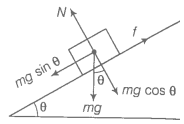Q. 41 A rectangular box lies on a rough inclined surface. The coefficient friction between the surface and the box is . Let the mass of the box be m.
(a) At what angle of inclination of the plane to the horizontal will the box just start to slide down the plane?
(b) What is the force acting on the box down the plane, if the angle inclination of the plane is increased to > ?
(c) What is the force needed to be applied upwards along the plane to make the box either remain stationary or just move up with uniform speed?
(d) What is the force needed to be applied upwards along the plane make the box move up the plane with acceleration a?


© 2025 GoodEd Technologies Pvt. Ltd.